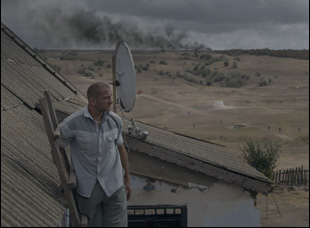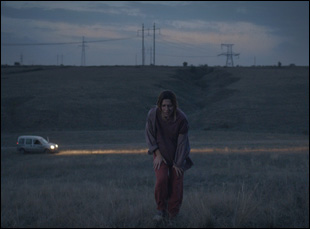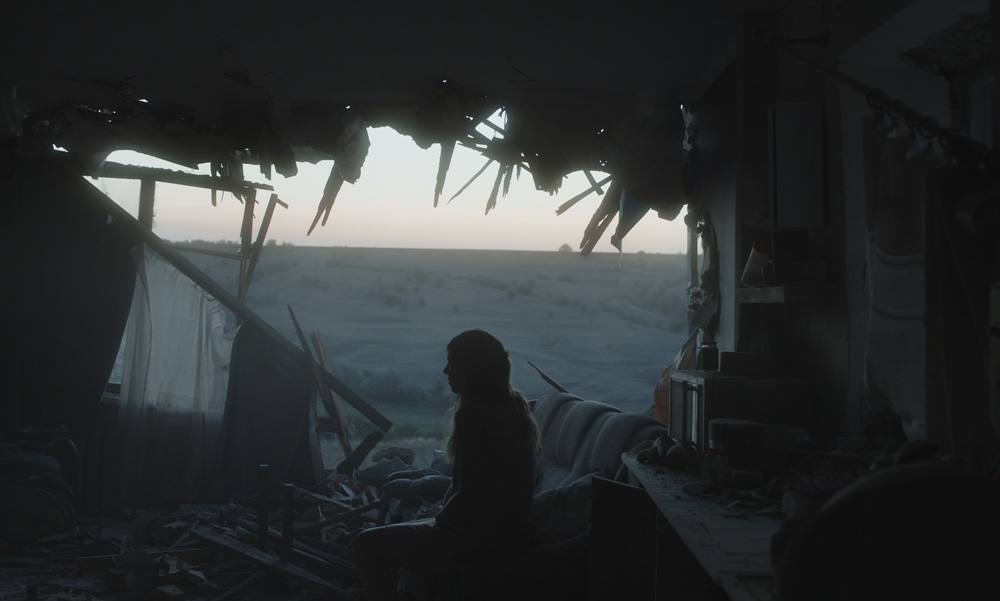Maryna Er Gorbach had thought about giving up on “Klondike.” It was 2019 when she was trying to find financing for the drama set on the edge of Eastern Ukraine where a village pilloried with Russian gunfire had become accustomed to all varieties of madness, only to still be shocked to see a plane fall out of the sky – Malaysia Airlines Flight 17, which was later identified to be part of a plot hatched by Russia with Ukrainian separatists and killed 298 passengers. While the writer/director wouldn’t compare getting a film off the ground with the exhaustion felt by Ukrainians who had endured so many horrors for so long due to their neighbors to the north, the film was having the usual struggles of an independent production of getting financing in place and she didn’t want to contribute to the the constant flow of media that was part of wearing her compatriots out until meeting with a friend at a coffee house in Kyiv where the two were relative safety from the violence of the region that’s been ongoing for decades, but not the less obvious yet no less destructive nature of being inundated by Russian culture, namely the blare of rap music that was inescapable.
“He told me you will hear this music until the first missile through your window,” Er Gorbach said, recollecting this moment at the Cinema Beltrade Festival last year in Milano. “It was such a painful sentence from him that I simply could not allow myself to be tired. It was a big pain. How could the only person that came from Donbass, lost his house, lost his family, lost everything, now in my Ukrainian city feel himself that alone?”
That music became the inspiration for the very first scene in “Klondike,” Er Gorbach’s devastating drama that was rightly celebrated upon its premiere at the 2022 Sundance Film Festival where the filmmaker picked up the award for Best Director, followed by a premiere at Berlinale where the film won the Panorama prize. Debuting less than a month before Russia would formally invade Ukraine, “Klondike” can feel as if it’s bearing witness to real time events though it is set in 2014 at the start of the Russo-Ukrainian war as it settles into a house with Irka (Oksana Cherkashyna) and her husband Tolik (Serhi Shadrin) where at least one of its walls has already been blown off. The two are expecting their first child in a couple of months and have done their best to create a sustainable life on their farm, with a cow and chickens around for basic sustenance and the choice of wallpaper depicting paradise letting the two escape in their imaginations to somewhere else, even if the reality of their situation is constantly rearing its ugly head.
While dodging bullets has sadly been accepted as a part of every day life for the pair, the plane crash can’t be ignored, bringing out both Russian and Ukrainian forces in the immediate aftermath wanting to know who shot the plane down and likely apt to take the few precious supplies that Irka and Tolik have on their land. Although “Klondike” hunkers down in the one location, with Irka’s brother Yaryk (Oleg Shcherbyna) arriving to help – though he may be more of a hinderance when he and Tolik have clearly had their differences for years – Er Gorbach pulls off the extraordinary in viscerally pulling one into the experience of living under such duress while envisioning the psychic impact that has on an entire society, often drawing this parallel without words in the same frame. While the filmmaker may have once worried that there was nothing new to say about the tragedy unfolding in Eastern Europe, “Klondike” becomes a bold statement that’s deeply affecting and after playing to a rousing reception at festivals around the globe, it begins its U.S. theatrical run this week and Er Gorbach graciously took the time to talk about cracking the film’s intricate structure, welcoming the input of her actors to shape their characters and how she found the film’s entrancing camera style.

Yeah, when I’m starting to write script, it might take months to think about where I’m coming [from] and I knew that this is the final scene because it’s a movie about war between destruction and creation, and this final scene is the peak point of creation. All of us will [experience] this, even if we don’t remember. And when I met with Oksana Cherkashina, who plays Irka, we started just talking about her role and about her actions and I told her that I will tell you one secret, but forget it. If we manage to do it, that will be our goal, and in the final scene, the woman and woman’s body, which represents creation, is stronger than war because we are on the side of creation. So that was the secret between me and Oksana [throughout filming]. We knew that it’s much more than just birth. It is about power of creation.
Oksana has said that you brought her and all actors were brought into your process early. What it was like to build the characters or to create a history with them?
Because there are long takes in the movie, it should be very well-prepared because we wanted to catch the sunrise and all gifts of the nature during [production], so it was super important to be ready with all the crew, especially with the actors. I’m always practicing the same rehearsal and preparation [for all my films] — I cast my actors and on “Klondike,” I had three and they didn’t know each other before, but [the audience] will watch a family [on screen], so for two months, we were just playing, acting small scenes from their life. These weren’t from a script [or in the actual film], just everything from their life since their childhood — the relations between sister and brother, relations with Tolik and Irka, just all very important moments of their life and it really helped us to create a family because in such films when viewers are watching family relations, there should be something much more than dialogue and action. There should be this family spirit.
They know very well why they have fights. I remember when we were rehearsing, Oleg Shcherbina, the actor who plays Yaryk, I was asking him after each time [we did a scene], “Why don’t you like Tolik? What’s the problem?” And he would explain to me each time [a reason to be angry at him] sometimes about political stuff, sometimes about family stuff, these logical explanations for a month [of rehearsals]. But then after one [time] when Yaryk just met Tolik for the first time and he saw that he’s sleeping in his room, and I asked Oleg, why you don’t like Tolik? And he just shouted “Because I just don’t like him.” And it was the the best answer because people sometimes just don’t like each other. It’s not about political conflicts. It’s about people characters. It happens sometimes. So that was how we built the family relations.
What was it like to build the house? The production design is quite effective for an audience watching when this house keeps revealing itself and reflects the mindsets of the characters inhabiting it, but I imagine it might’ve had that effect on the actors as well.
Yeah, it was for us, this small world because in the beginning we have we the dream on the wall [reflecting a tropical sunset], and basically, Irka and Tolik’s relationship — she has different ideas [than he does] and Tolik is nonstop making something for his wife — this is how their love exists — and we are starting this movie in the morning when this dream, when their small paradise, which they created, was bombed, and they have to leave, so you can see different conditions of the house. Irka is cleaning because this is her nest. This is her dream. And then Tolik tries to renovate the house, thinking about the future where their baby is going to have a shower and Yaryk also helps them. So I never was making a scene only about the house, but the house is always there because it is private [for them] and no one has any right to destroy it or to step in.

Yes, it was very important because we always have an action on the border and this is the house is on the border, so I really wanted to have this border [visible] during the whole film and this [location] looks like the Hrabove village where the MH17 catastrophe happened. It was not really hard to find because we asked Ukrainian National Geography Institute to help us, and they gave us maps, so we were traveling around Ukraine. Specifically in those villages, it was a bit hard because it was COVID times in 2020, so it was a guerrilla preproduction because there are no hotels and no places to eat and so on. But thanks to our cinematographer, Svetoslav Bulakovsky, who was just driving and shooting photographs – and he would sleep in his car – he was sending [all this] to me. We found a few villages and then [once] I came, we finalized it. I’m super happy that we have this border of countries, but also the border of life and death, of starting and ending of the day, of the sun and of nature. We have this all the time in the field. It was very important.
There’s a scene where a little rain falls between the time it starts and the time the shot ends that really stuck with me since it seems like you couldn’t have faked it. What was it like working with the weather?
It was really hard to believe, but weather was with us. The rain just just just started when we were really ready to shoot this take, but the same also with clouds, because there is a scene when Yaryk and Tolik as they have a fight, and when Irka is angry and she’s walking [away], you can see huge clouds. These clouds were written in my script, but the crew was asking me how we are going to do this? Do we have CGI? And then when we started to shoot — and [performance-wise] that was our best take actually — Irka started to walk, and if you watch the scene from the beginning, there are no clouds, but it was very important to have huge clouds, and suddenly the clouds were [almost] touching her, touching the earth. It was a miracle really happened. And I remember the crew came to me at the monitor and said, “Do you see this?” And I said, “Of course, I see. Let’s help the clouds and make small wings.” It was really so beautiful and so powerful when nature appears in the film. It gives magic.
The rhythm of the shooting style is quite absorbing, and I’ve heard you compare it to breathing. Was it something you knew from the start or did that style developing over the course of filming?
Ninety-nine percent of movie are dolly takes, and when we started to shoot, [we were] looking to the monitor, because this is this is how things [generally] happen, but the spirit of the film and the speed of it was not just about picture, but this breathing tempo. And I said to [our cinemtographer] that I will breathe next to you — I will give you this speed of the breathing, so please don’t look to the monitor. Just go with this breath because somehow we want our viewers to breath with us. We want to connect them with our breaths — with our shocks, stress, with our feelings. So he started to go with this breathing speed and he just really started to feel it, not only looking to the monitor, and then it worked. And when I finished the film, I even wrote in my diary that I believe that cinema is a way to change the speed of viewers’ breathing. If I can change the speed of your breathing when you’re watching the film, that’s cinema.
I imagine this past year since the film’s premiere at Sundance has been filled with mixed feelings when as a filmmaker you want to speak to the moment, but this film is all too relevant. What’s it been like for you getting this out into the world?
On one side, as a human, my one hand is on the phone with my friends and my relatives in Ukraine, and another is booking flights to another country to fly and to show the movie. There is no real time for emotional reflection. It’s super busy, but now I can say that I am sad that there was a reason to create “Klondike.” Because if there is no war, there is no reason to create “Klondike.” And a movie cannot stop any war, but [the film] gave to me a personal voice and that was my way to survive.I know that I have a movie and I really, really can touch people’s hearts as much as I can, so that was for me the best help to go through this all. I didn’t feel myself a victim, a powerless director who can do nothing against war. I knew that I have a voice because I have a movie, and that was my power.
“Klondike” opens on August 4th in New York at the Angelika Film Center, Los Angeles at the Laemmle Royal and in Sedona, Arizona at the Alice Gill-Sheldon Theatre.




